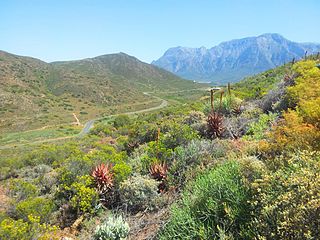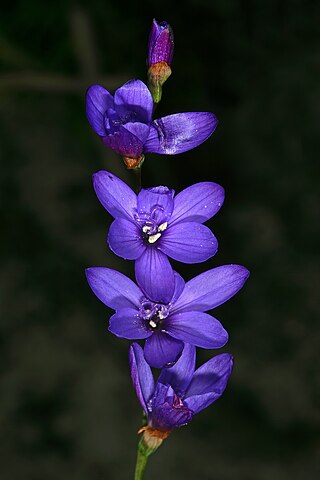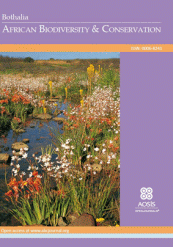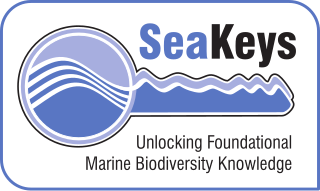
Kirstenbosch is an important botanical garden nestled at the eastern foot of Table Mountain in Cape Town. The garden is one of 10 National Botanical Gardens covering five of South Africa's six different biomes and administered by the South African National Biodiversity Institute (SANBI). Prior to 1 September 2004, the institute was known as the National Botanical Institute.
The Department of Forestry, Fisheries and the Environment (DFFE) is one of the departments of the South African government. It is responsible for protecting, conserving and improving the South African environment and natural resources. It was created in 2019 by the merger of the Department of Environmental Affairs with the forestry and fisheries components of the Department of Agriculture, Forestry and Fisheries.

The South African National Bioinformatics Institute (SANBI) is a non-profit organisation in Cape Town, South Africa dedicated to bioinformatics, biotechnology and genomics in health research.
Wendy Foden is a conservation biologist, best known for her work on climate change impacts on biodiversity.

The Pretoria National Botanical Garden is one of South Africa's nine National Botanical Gardens. The garden is wedged between Pretoria Road and Cussonia Avenue in Brummeria, in eastern Pretoria, Gauteng, and flanks a central rocky ridge that runs from east to west. The 76 hectares (0.76 km2) garden was established in 1946, and of late hosts the headquarters of the South African National Biodiversity Institute.
The Mokopane Biodiversity Conservation Centre was established in 1979 and opened to the public in October 1981, as a satellite of the National Zoological Garden (NZG), Pretoria Zoo. In 2004 the NZG was proclaimed as a National Facility, as part of the National Research Foundation of South Africa (NRF). In April 2018 the Mokopane BCC was transferred to the National Department of Environment, Fisheries and Forestry as campus of the South African National Biodiversity Institute (SANBI).

The Harold Porter National Botanical Garden covers almost 200 ha between mountain and sea, in the heart of the Cape Fynbos region within the Kogelberg Biosphere Reserve to the east of Cape Town, South Africa, specifically near Betty's Bay along Clarence Drive (R44). With about 1,600 plant species, the area contains a floral diversity per unit area that is greater than anywhere else in the world. The Garden consists of 10 hectares of cultivated gardens and 190.5 hectares of pristine natural fynbos. In addition, 60 species of birds can be found there, as well as porcupines, genets, skunks, hyraxes, baboons, and snakes. Foot trails reach cliffs, ravines, heaths, forests, streams, and mountain pools.

The Karoo Desert National Botanical Garden is a botanical garden focused on succulents and other plants of arid regions, that lies at the foot of the Hex River Mountains range, in the town of Worcester, South Africa.

Marie Prins is a South African botanist.

Geissorhiza aspera, also known as the blue satin flower or blou sysie, is a geophyte from South Africa.

iSpot is a website developed and hosted by the Open University with funding from the Open Air Laboratories (OPAL) network with an online community intended to connect nature enthusiasts of all levels.
The South African National Biodiversity Institute (SANBI) is an organisation tasked with research and dissemination of information on biodiversity, and legally mandated to contribute to the management of the country's biodiversity resources.
Graham Dugald Duncan(born 1959) is a South African botanist and specialist bulb horticulturalist at the Kirstenbosch National Botanical Garden, Cape Town, South Africa.

African Biodiversity & Conservation, formerly known as Bothalia is a South African peer-reviewed open access scientific journal covering the fields of botany, zoology and biodiversity, produced by the South African National Biodiversity Institute. According to the Journal Citation Reports, the journal has a 2017 impact factor of 0.52.

The Marine biodiversity of South Africa is the variety of living organisms that live in the seas off the coast of South Africa. It includes genetic, species and ecosystems biodiversity in a range of habitats spread over a range of ecologically varied regions, influenced by the geomorphology of the seabed and circulation of major and local water masses, which distribute both living organisms and nutrients in complex and time-variable patterns.

SeaKeys is a large collaborative marine biodiversity project funded through the Foundational Biodiversity Information Program in South Africa. The purpose of the project is to collect and distribute genetic, species and ecosystem information relating to marine biodiversity in southern Africa, which may be used to support informed decision-making about the marine environment.
The Biodiversity of South Africa is the variety of living organisms within the boundaries of South Africa and its exclusive economic zone. South Africa is a region of high biodiversity in the terrestrial and marine realms. The country is ranked sixth out of the world's seventeen megadiverse countries, and is rated among the top 10 for plant species diversity and third for marine endemism.

Brian John Huntley is a retired professor and conservation scientist from South Africa, best known for developing and transforming African national parks. He was involved in expanding the National Botanical Institute to become an authoritative repository on South African flora and fauna. As an independent expert, he was a consultant for agencies and international organizations, including the United Nations, with regard to nature conservation. He himself took part in multiple conservation projects around Africa.
Alan Christoffels is a bioinformatics scientist, academic, and an author. He is Professor of Bioinformatics, and the director of the South African National Bioinformatics Institute at the University of the Western Cape. He has been serving as a senior advisor to the Africa Centres for Disease Control and Prevention Pathogen genomics & Partnerships and DSI/NRF Research Chair in Bioinformatics and Public Health Genomics.
Athanasia pectinata is a species of plant from the Western Cape of South Africa.











